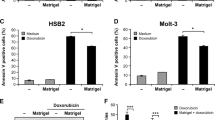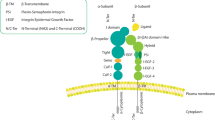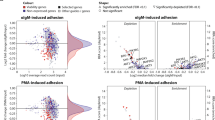Abstract
The microenvironment has been shown to influence tumor cell phenotype with respect to growth, metastasis, and response to chemotherapy. We have utilized oligonucleotide microarray analysis to identify signal transduction pathways and gene products altered by the interaction of myeloma tumor cells with the extracellular matrix component fibronectin that may contribute to the antiapoptotic phenotype conferred by the microenvironment. Genes with altered expression associated with fibronectin cell adhesion, either induced or repressed, were numerically ranked by fold change. FN adhesion repressed the expression of 469 gene products, while 53 genes with known coding sequences were induced by twofold or more. Of these 53 genes with two fold, or greater increase in expression, 11 have been reported to be regulated by the nuclear factor-kappa B (NF-κB) family of transcription factors. EMSA analysis demonstrated NF-κB binding activity significantly increased in cells adhered to fibronectin compared to cells in suspension. This DNA binding activity consisted primarily of RelB-p50 heterodimers, which was distinct from the NF-κB activation of TNFα. These data demonstrate the selectivity of signal transduction from the microenvironment that may contribute to tumor cell resistance to programmed cell death.
This is a preview of subscription content, access via your institution
Access options
Subscribe to this journal
Receive 50 print issues and online access
$259.00 per year
only $5.18 per issue
Buy this article
- Purchase on Springer Link
- Instant access to full article PDF
Prices may be subject to local taxes which are calculated during checkout




Similar content being viewed by others
References
Bearz A, Tell G, Colombatti A, Formisano S and Pucillo C . (1998) Biochem. Biophys. Res. Commun., 243, 732–737.
Bian X, McAllister-Lucas LM, Shao F, Schumacher KR, Feng Z, Porter AG, Castle VP and Opipari Jr AW . (2001). J. Biol. Chem. 276, 48921–48929.
Catlett-Falcone R, Landowski TH, Oshiro MM, Turkson J, Levitzki A, Savino R, Ciliberto G, Moscinski L, Fernandez-Luna JL, Nunez G, Dalton WS and Jove R . (1999). Immunity, 10, 105–115.
Chen C, Edelstein LC and Gelinas C . (2000). Mol. Cell. Biol., 20, 2687–2695.
Chu Z-L, McKinsey TA, Liu L, Gentry JJ, Malim MH and Ballard DW . (1997). Proc. Natl. Acad. Sci. USA, 94, 10057–10062.
Damiano JS, Cress AE, Hazlehurst LA, Shtil AA and Dalton WS . (1999). Blood, 93, 1658–1667.
Do RK and Chen-Kiang S . (2002). Cytokine Growth Factor Rev., 13, 19–25.
Do RK, Hatada E, Lee H, Tourigny MR, Hilbert D and Chen-Kiang S . (2000). J. Exp. Med., 192, 953–964.
Feinman R, Koury J, Thames M, Barlogie B, Epstein J and Siegel DS . (1999). Blood, 93, 3044–3052.
Green SK, Frankel A and Kerbel RS . (1999). Anticancer Drug Des., 14, 153–168.
Grumont RJ, Rourke IJ and Gerondakis S . (1999). Genes Dev. 13, 400–411.
Gugasyan R, Grumont R, Grossmann M, Nakamura Y, Pohl T, Nesic D and Gerondakis S . (2000). Immunol. Rev., 176, 134–140.
Hazlehurst LA, Damiano JS, Buyuksal I, Pledger WJ and Dalton WS . (2000). Oncogene, 19, 4319–4327.
Hazlehurst LA, Valkov N, Wisner L, Storey JA, Boulware D, Sullivan DM and Dalton WS . (2001). Blood, 98, 1897–1903.
Hideshima T, Richardson P, Chauhan D, Palombella VJ, Elliott PJ, Adams J and Anderson KC . (2001). Cancer Res., 61, 3071–3076.
Karin M and Lin A . (2002). Natl. Immunol., 3, 221–227.
Kudoh K, Ramanna M, Ravatn R, Elkahloun AG, Bittner ML, Meltzer PS, Trent JM, Dalton WS and Chin KV . (2000). Cancer Res., 60, 4161–4166.
Liou HC, Sha WC, Scott ML and Baltimore D . (1994). Mol. Cell Biol., 14, 5349–5359.
Mayo MW and Baldwin Jr AS . (2000). Biochim. Biophys. Acta, 1470, 55–62.
Micheau O, Lens S, Gaide O, Alevizopoulos K and Tschopp J . (2001). Mol. Cell. Biol., 21, 5299–5305.
Qwarnstrom EE, Ostberg CO, Turk GL, Richardson CA and Bomsztyk K . (1994). J. Biol. Chem., 269, 30765–30768.
Rosales C and Juliano R . (1996). Cancer Res., 56, 2302–2305.
Scupoli MT, Fiorini E, Marchisio PC, Poffe O, Tagliabue E, Brentegani M, Tridente G and Ramarli D . (2000). J. Cell Sci., 113, 169–177.
Shain KH, Jove R and Olashaw NE . (1999). J. Cell Biochem., 73, 237–247.
Shain KH, Landowski TH and Dalton WS . (2002). J. Immunol., 168, 2544–2553.
St Croix B, Florenes VA, Rak JW, Flanagan M, Bhattacharya N, Slingerland JM and Kerbel RS . (1996). Nat. Med., 2, 1204–1210.
Van Antwerp DJ, Martin SJ, Kafri T, Green DR and Verma IM . (1996). Science, 274, 787.
Wang C-Y, Cusack JC, Liu R and Baldwin Jr AS . (1999b). Nat. Med., 5, 412–417.
Wang C-Y, Guttridge DC, Mayo MW and Baldwin Jr AS (1999a). Mol. Cell. Biol., 19, 5923–5929.
Wang C-Y, Mayo MW and Baldwin Jr AS (1996). Science, 274, 784–787.
Wang C-Y, Mayo MW, Korneluk RG, Goeddel DV and Baldwin Jr AS (1998). Science, 281, 1680–1683.
Xiao G, Harhaj EW and Sun SC (2001). Mol. Cell, 7, 401–409.
Zong W-Z, Edelstein LC, Chen C, Bash J and Gelinas C (1999). Genes Dev., 13, 382–387.
Acknowledgements
This work was supported by the National Cancer Institute (CA77859 and CA82533 to WSD), and the Peninsula Community Foundation for Myeloma Research. We also thank the H Lee Moffitt Flow Cytometry and Microarray Core Facilities (CA76292).
Author information
Authors and Affiliations
Corresponding author
Rights and permissions
About this article
Cite this article
Landowski, T., Olashaw, N., Agrawal, D. et al. Cell adhesion-mediated drug resistance (CAM-DR) is associated with activation of NF-κB (RelB/p50) in myeloma cells. Oncogene 22, 2417–2421 (2003). https://doi.org/10.1038/sj.onc.1206315
Received:
Revised:
Accepted:
Published:
Issue Date:
DOI: https://doi.org/10.1038/sj.onc.1206315
Keywords
This article is cited by
-
Myeloma bone disease: pathogenesis and management in the era of new anti-myeloma agents
Journal of Bone and Mineral Metabolism (2023)
-
High FRMD3 expression is prognostic for worse survival in rectal cancer patients treated with CCRT
International Journal of Clinical Oncology (2021)
-
COX2 confers bone marrow stromal cells to promoting TNFα/TNFR1β-mediated myeloma cell growth and adhesion
Cellular Oncology (2021)
-
Integrins in multiple myeloma
Inflammation and Regeneration (2020)
-
Elucidating the expression and function of Numbl during cell adhesion-mediated drug resistance (CAM-DR) in multiple myeloma (MM)
BMC Cancer (2019)



